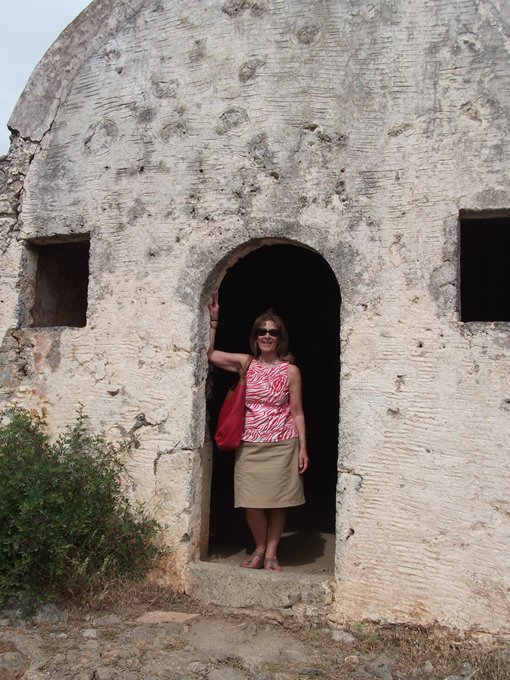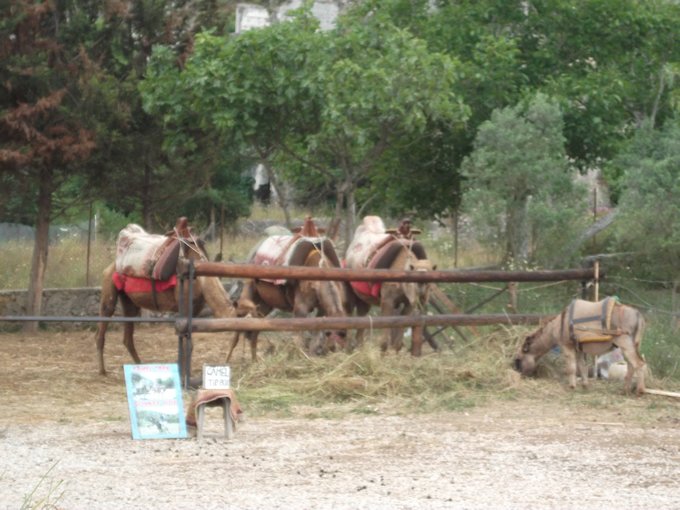Kayakoy

Tuesday 3rd June, 2014.
We called the marina and moved into it as the weather forecast for the next two days is strong winds from the SE. We decided it was safer to be on a pontoon rather than worry about the anchor slipping or the neighbours swinging into you.
After we were tied up and safe we walked to the market in Fethiya. It was fabulous and the biggest we had ever seen. There was the fruit and vegetable market which covered a huge area together with clothes, household goods and stalls set out like restaurants with table clothes, pretty covered chairs. Obviously we could not resist the cherries and strawberries on show or the pancake lunch with spinach and cheese or cheese and mushrooms.
Jim decided to return to Ariel as the gusts were coming and going while Christine and I took the bus to Kayakoy. We knew it was a deserted village but we were not prepared for the size of the place. Among the houses are churches and tombs. Between the Lycian and current Turkish name the town was once called Levissi and was very important on the Turkish coast as it was an island. It is thought the Greek speaking Christians population fled the area around 700AD as the area fell into the hands of pirates and raiders. The Christians moved to the area we know as Kayakoy and were safe. At its peak there were 2,000 houses and 4 churches. Rainwater was stored in each house and each tank hold 4 to 8 ton of water. The public water was channelled over the mountain from Hisaronu several miles away by clay pipes and later steel pipes.
Levissi continued to prosper until the end of the first world war when civil war broke out between the Greek and Turkish populations of western Anatolia although there was no recorded record of any fighting in the Levissi town. Many of the young men of Kayakoy went to the front and never returned. The founder of modern secular Turkey was Kemal Ataturk and he lead the Turks to victory and drove back the Greeks.
The British broke a peace treaty in September 1923 and as a solution the treaty of Lausanne was agreed and an exchange of populations based on religion took place. 1,200,000 Greek speaking Christians were sent to Greece whilst 400,000 Turkish speaking Muslims were displaced from the Macedonian regions of Greece to be resettled in Turkey. In the months following the treaty many of the Greeks left voluntarily to return to mainland Greece or onto Australia. Following the treaty the compulsory eviction of the remaining Greeks took place and the valley was left with only the peasant farmers scattered around the valley overlooked by a ghost town.
The roofs of the houses were straw and mud and without regular maintenance were prone to weather damage and one by one they collapsed and this started the slow deterioration of the houses. The final blow to the town was the earthquake of 1957 when the local government gave permission for the local farmers to use the remaining timbers for reconstruction. In the 1980’s the government recognised the importance of the town as an historical site and it was declared an UNESCO World Heritage site.
We saw camels at the base of the village which you could ride and while at the bus stop a family of geese came along hissing at everyone. We had our handbags in front of our knees just in case whereas the poor dog that was sleeping got pecked on the bottom and chased away.
The bus arrived on schedule and we were back in Fethiya thirty minutes later.









